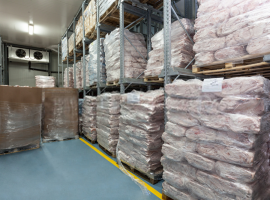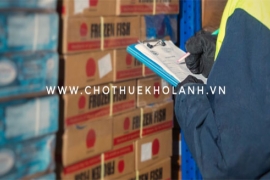TRANSPORTATION SERVICE OF FROZEN GOODS - NAM HA NOI COLD STORAGE
2020 is a difficult year for many frozen freight service businesses in particular and the whole logistics industry in general. The impact of the Covid-19 pandemic, the US-China confrontation, the US general election, etc. in the past year have caused great changes to the cold transport service supply chain in Vietnam.
Freight services under the impact of Covid-19 pandemic
Nam Ha Noi cold storage would like to give some examples extracted from the report of the General Statistics Office in October 2020 as follows:
- In October 2020, the number of newly established transportation and warehousing enterprises decreased by 5.5% compared to the same period last year (reaching 4513 enterprises, but lower than the general decrease of all industries).
- From the beginning of the year to the end of October 2020, 2366 transportation and warehousing enterprises in Vietnam have completed dissolution procedures.
- Domestic transport in the first 10 months of 2020, reaching 1.403 billion tons, decrease 7.9%; Freight rotation reached 145.6 billion ton.km, decrease 12.2% over the same period last year. Overseas freight reached 26.3 million tons, decrease 18.6%; Rotation reached 127.9 billion ton.km, decrease 4.6% over the same period last year
- In terms of freight volume, road still accounted for the largest proportion (about 74.35%) of the total transport volume in October 2020. Followed by inland waterways (20.97%), sea routes (4.42%). Meanwhile, the share of railway and airway is very low, 0.22% and 0.01% respectively.
As of October 2020, Vietnam has controlled the pandemic and stabilized the socio-economic situation back to normal. Although many of the transport indicators (%) indicated above are lower than the same period in 2019, our country's freight rotation has been more active than in the past if we see it objectively. Some positive signs are:
- In the first 10 months of 2020, the total volume of cargo through Vietnam's seaports reached nearly 576.5 million tons. The volume of container cargo through the seaport reached more than 18 million TEUs, increase 12% over the same period in 2019.
- The size of container ships has increased rapidly in recent years, the number of ships with a capacity of more than 10,000 TEUs has been ordered and built more and more.
- Seaports across the country are being concerned by many investors (including the EU, the US, etc.) wanting to improve their competence and ability to receive goods to the maximum.
After the Covid-19 pandemic, the transportation of frozen goods is considered as an industry with great development potential. Especially when the sales and distribution network of cold and frozen food is expanding both online and at stores and supermarkets. In addition, the e-commerce channel has witnessed a "boom" in the past year, when the number of online shoppers increased by 25%, leading to an increasing demand for warehousing and domestic transportation than ever.
Many retail businesses are in dire need of a warehouse system that specializes in serving the needs of food storage, distribution, delivery, etc. for retail channels and customers in different regions (from urban to rural areas). Therefore, investing in freight services with warehousing is a prerequisite in the development orientation of several companies today.
Investment in frozen goods transportation is a necessary condition to develop the retail industry
The Covid-19 pandemic has changed the picture of retail in 2020: Consumers are gradually tending to shop online rather than direct shopping (traditional retail channels such as markets, supermarkets, shopping malls, etc.) and switch from using fresh food to frozen food for storage and long-term usage. These changes have posed many challenges for businesses such as: How to optimize costs, catch up with trends and increase competitiveness in the market? The answer is the freight and the storage of the businesses.
Transportation and storage, two factors that businesses need to pay attention to
Many businesses believe that the best way to optimize costs is to raise prices or sell as many products as possible. But that is only true when the business distributes exclusively and does not have to compete with any other company. In fact, all retail businesses struggle in a "red ocean" of many competitors. They are forced to find other solutions to compete and save costs, including optimizing transportation and warehousing.
Over 50% of products on the retail market today are perishables (i.e. fresh foods and products with a short shelf life).
Commodities such as meat, seafood, eggs, milk, vegetables, ... are indispensable products of the retail industry. With great purchasing power and high profit, perishable goods are sold at most retail outlets (both online and traditional). However, this type of product has a major disadvantage that it is very perishable and often degrades in quality if not stored and transported properly.
For example: For agricultural products, due to their specific characteristics (such as short shelf life, perishability, seasonality, etc.), companies need a closed and integrated process from the stage of production, harvesting, processing, packing, storage, transportation and distribution to the final consumer.
However, the freight as well as storage and preservation in Vietnam are still not properly invested, especially in the cold chain (the supply chain controls the goods temperature during transportation so that they are always in the best condition).
Let take agricultural products as an example: If businesses do not use appropriate means of transportation as well as do not have the right preservation methods, it is easy for agricultural products to sprout, rot, etc. causing heavy losses. For the retail industry in general and the perishable food industry in particular to develop, businesses need to pay more attention and invest in cold chain as well as freight.
The role of refrigerated freight services in the retail industry
Cold storage systems combined with freight services or in other words, cold chain is playing an important role in the retail industry:
- Allowing perishable goods to achieve the most precise storage conditions, differentiated by type and temperature required to maintain the standard quality.
- Adding value to perishable goods (such as agricultural products) by maintaining and extending the product's life cycle.
- Supporting the state in food hygiene and safety management activities: domestic consumption and export. Improving the living quality for people and providing enough food during the isolation period because of the Covid-19 epidemic.
- Food stored in the best conditions will bring high nutritional value to consumers, thereby increasing customer satisfaction and protecting the environment.
The cold storage system combined with good operation of freight services leads to a reduction in the loss and waste of goods and national resources, protects the flora and fauna ecosystem and contributes to the sustainable economic growth. As a result, the amount of goods supplied to the local market will increase, contributing to meet more and better the local and domestic consumer demand. Less loss means more product volume. Therefore, perishable products such as agricultural products, aquatic products, fruits, etc. can be exported to different countries in the world over long distances, but the quality is maintained for a long time due to the conditions generated by the cold chain.
By creating suitable temperature and humidity conditions for cargoes during transportation from the port to the warehouse, from the warehouse to retail stores and vice versa, the products are always fresh and of guaranteed quality when reaching the consumers. Refrigerated transport service brings practical benefits in reducing production and business costs, increasing efficiency and reducing losses for perishable goods supply chains.
Currently, many businesses are in need of a warehouse system that specializes in serving the storage and preservation needs of goods and food transportation services for modern retail channels. Especially the businesses and customers in Hanoi City and the Northern region where trading between major markets and huge source of import and export goods from Hai Phong port and border gates (Mong Cai, Huu Nghi – China, Tay Trang, Chieng Khuong - Laos, etc.). So where is the cold storage rental address with the appropriate transport and storage system that businesses are looking for? Please read the information below for more options.
Cold storage address in Hanoi with freight service
Nam Ha Noi Cold Storage is one of the large cold storages in the North with a capacity of up to 5000 tons, including different separate warehouses with a capacity of 300 - 1500 tons per warehouse. The ability to receive and store a large quantity of goods gives us ability to satisfy the needs of retailers, preserve and classify products in the most optimal way.
Nam Ha Noi cold storage is located in a prime transportation location: the Southern gateway of Hanoi capital at Quat Dong cluster, Thuong Tin district, Ha Noi, right next to the National Route 1A, helping goods preserved here can be circulated and reach the delivery location as quickly as possible. With a fleet of trucks and yards for transporting vehicles, your goods will be guaranteed to maintain a stable temperature from the time they are loaded into the vehicle until they are stored.
We also equip more modern machines to make importing and exporting, loading and unloading, and arranging goods easier. Along with the Bitzer compressor, Linde and Komatsu forklifts, Testo temperature monitoring and recording system, CUMMINS 350kVA generator, etc. is a team of experienced and professional staff, who are always dedicated to the job and serve customers in the most conscientious way. Under our preservation and temperature monitoring, your goods will always maintain the best quality. For the best advice on cold storages, contact us via the hotline 0772.84.9999 for more details







